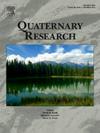Mid- to Late Holocene geomorphodynamics in a long-term settled mountain catchment in the Pergamon micro-region, western Turkey
IF 1.8
3区 地球科学
Q3 GEOGRAPHY, PHYSICAL
引用次数: 1
Abstract
Abstract From 300 BC to AD 300, the city of Pergamon underwent a profound transformation that impacted the rural settlement patterns and the concomitant geomorphodynamics. We present a geoarchaeological study in a long-term settled catchment in the Pergamon micro-region to disentangle the Holocene geomorphodynamics and triggering factors, for example, climate change and human activity. The analyses of eight radiocarbon-dated sediment profiles from the Tekkedere alluvial fan and its catchment indicate four principal sedimentation phases. Phase 1 (ca. 6.2 to 5–4 ka) is dominated by the floodplain aggradation of the receiving Bakırçay River, which is followed by the formation of floodplain soils (phase 2). Substantial geomorphodynamic changes occurred around 4 ka (phase 3), when the edge of the floodplain was buried by fan sediments of the tributary Tekkedere creek. This is attributed to supraregional aridization and rapid climate change events, superimposed by the onset of local human activities. Repeated cycles of coarse- and fine-textured fan sediments with age inversions after ca. 3.8 ka and valley infills younger than 1300 yr BP indicate the strong erosion and redeposition of sediments in phase 4. These increased geomorphodynamics may coincide with the changing settlement pattern and thus reflect human–environment interactions.土耳其西部佩加蒙微区长期定居山区全新世中期至晚期地貌动力学
摘要从公元前300年到公元300年,佩加蒙市经历了一场深刻的变革,这场变革影响了农村定居模式和随之而来的地貌动力学。我们在佩加蒙微区的一个长期定居流域进行了地质考古研究,以理清全新世地貌动力学和触发因素,例如气候变化和人类活动。对Tekkedere冲积扇及其集水区的八个放射性碳年代沉积物剖面的分析表明,有四个主要沉积阶段。第1阶段(约6.2至5–4 ka)主要是受纳Bakırçay河的泛滥平原沉积,随后形成泛滥平原土壤(第2阶段)。4 ka左右(第3阶段)发生了实质性的地貌动力学变化,当时泛滥平原的边缘被支流Tekkedere溪的扇沉积物掩埋。这归因于超区域干旱化和快速气候变化事件,再加上当地人类活动的开始。在约3.8ka之后,粗纹理和细纹理扇沉积物的重复循环和年龄倒置,以及小于1300年BP的山谷填充,表明第4阶段沉积物受到强烈侵蚀和再沉积。这些增加的地貌动力学可能与不断变化的定居模式相吻合,从而反映了人类与环境的相互作用。
本文章由计算机程序翻译,如有差异,请以英文原文为准。
求助全文
约1分钟内获得全文
求助全文
来源期刊

Quaternary Research
地学-地球科学综合
CiteScore
4.70
自引率
8.70%
发文量
57
审稿时长
3 months
期刊介绍:
Quaternary Research is an international journal devoted to the advancement of the interdisciplinary understanding of the Quaternary Period. We aim to publish articles of broad interest with relevance to more than one discipline, and that constitute a significant new contribution to Quaternary science. The journal’s scope is global, building on its nearly 50-year history in advancing the understanding of earth and human history through interdisciplinary study of the last 2.6 million years.
 求助内容:
求助内容: 应助结果提醒方式:
应助结果提醒方式:


